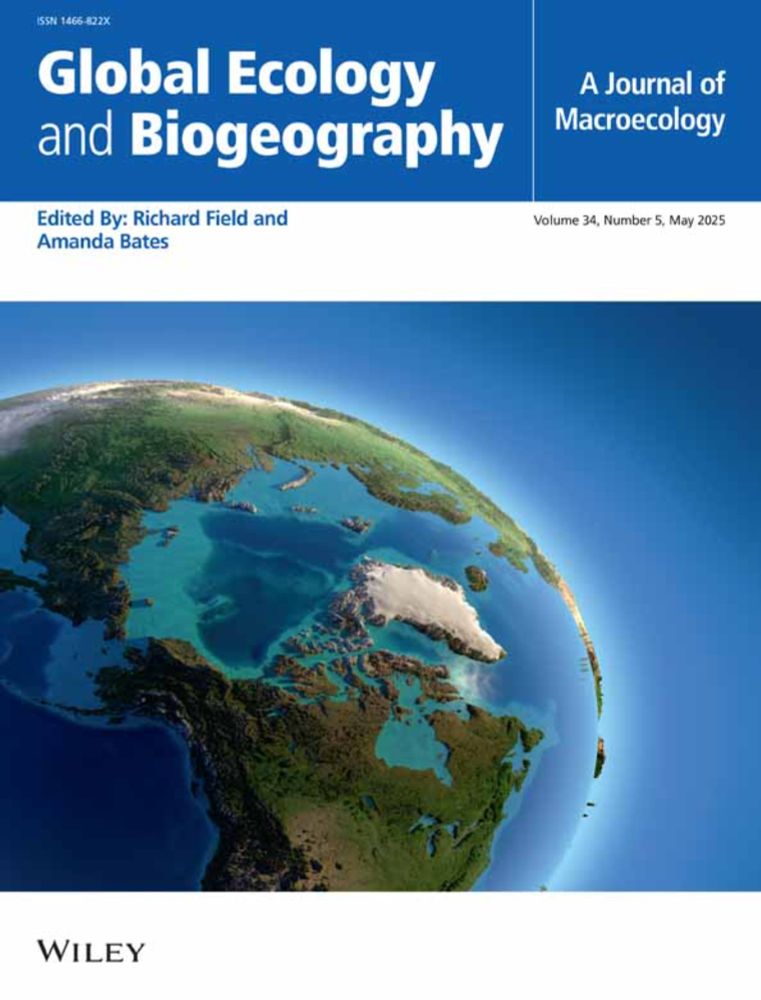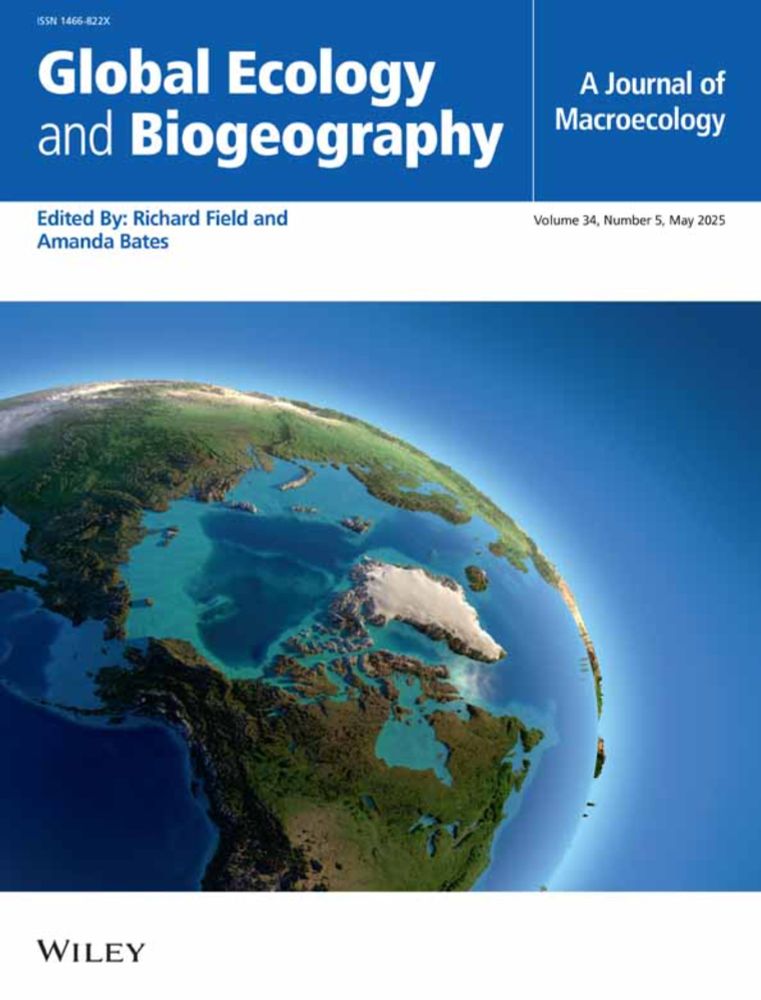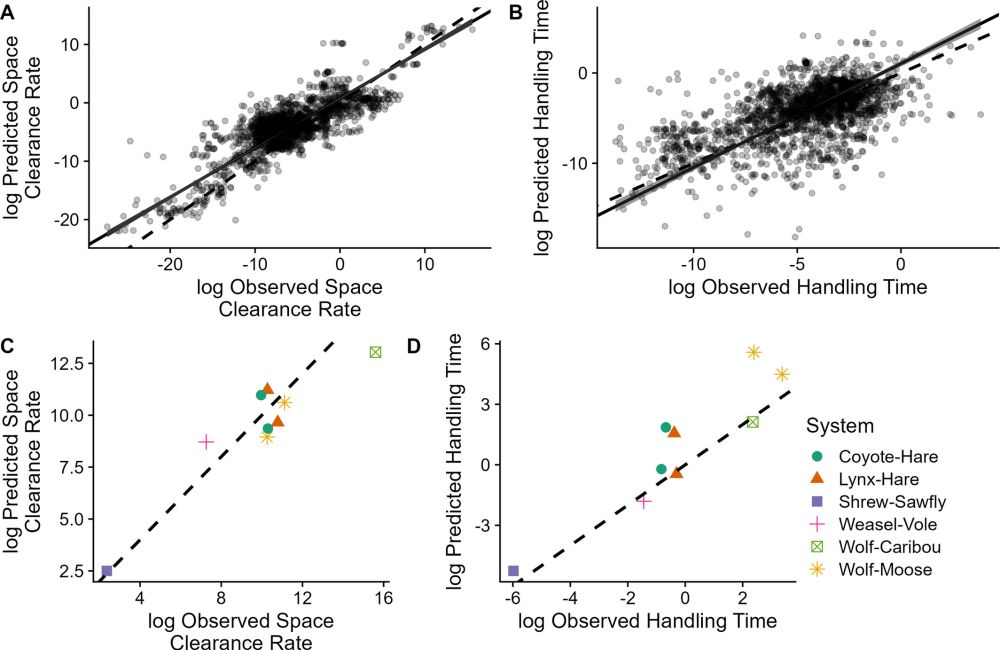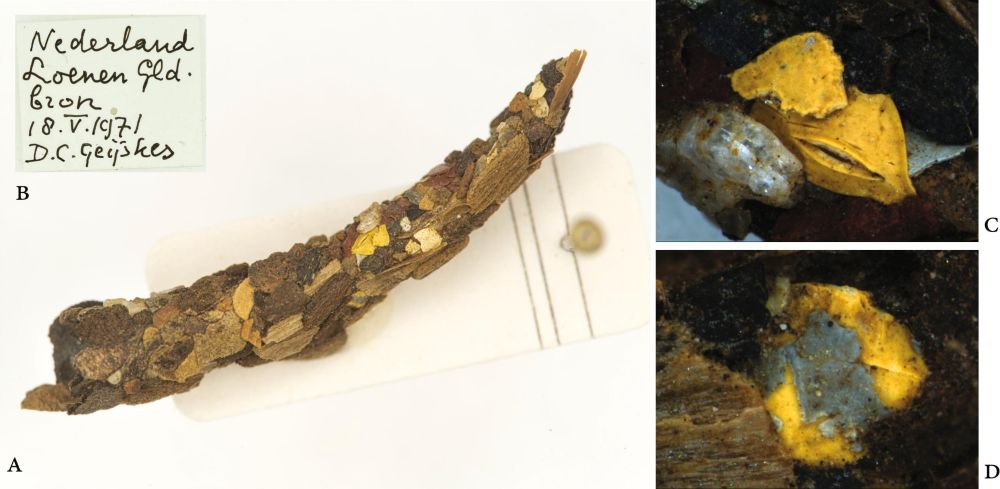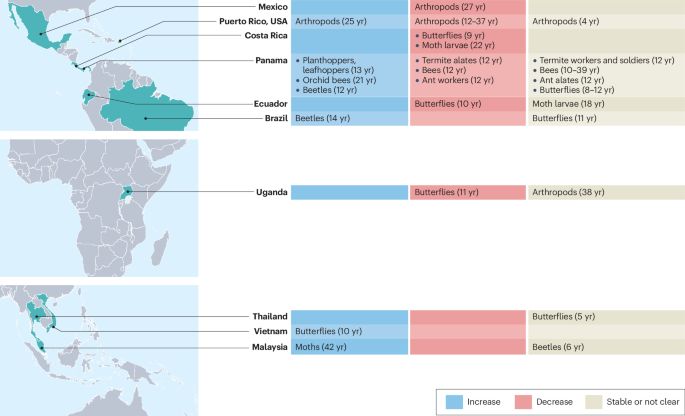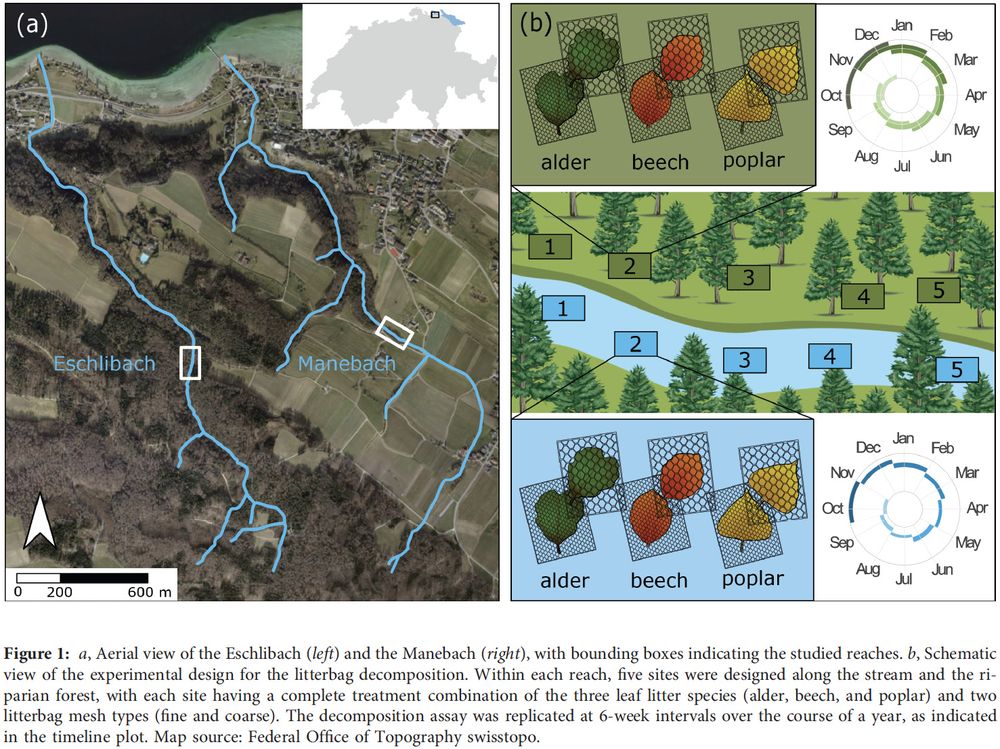
The #phenology of leaf litter decomposition in #aquatic & #terrestrial compartments of #headwater streams
@asn-amnat.bsky.social:
www.journals.uchicago.edu/doi/10.1086/...
🌐🌍🌿🍂⏱️
We studied how blue-green 🟦🟩 systems are connected by resource flows and how ecosystem processes vary seasonally.
1/4🧵
28.06.2025 10:13 — 👍 14 🔁 7 💬 1 📌 0

Restoration of aquatic habitat complex extends the foraging window of terrestrial consumers
Cross-ecosystem linkages benefit generalist consumers by providing prey fluxes from donor habitats, but these trophic connections are highly vulnerabl…
Restoration ecology that considers biotic interactions is essential if goals include restoring species. Constructed wetlands complement adjacent streams by supplying emergent aquatic insect subsidies asynchronously, extending the foraging window for terrestrial consumers #foodweb #landscapediversity
28.06.2025 05:55 — 👍 11 🔁 3 💬 0 📌 0
Interested in #ecological #theory & live on this side of the world (Asia-Pacific)? Tune in to the @pop-bio.bsky.social seminar series! I'm speaking next on #biodiversity change, #food-web energetics and #ecosystem function. Register here: forms.gle/7vEiUQKJqeUL... 🌐🌏🍁🧪 @newzealandecology.bsky.social
23.06.2025 21:54 — 👍 16 🔁 5 💬 1 📌 0
📣Post-doc opportunity in thermal ecology & species interactions with Arnaud Sentis at INRAE Aix-en-Provence, France.
🌡️Explore how antagonistic interactions shape thermal tolerance in freshwater organisms.
📆 Start: Nov. 2025 | Duration: 2 years
📩 Sept. 8, 2025
Info 👉 www.inrae.fr/en/news/erc-...
🌐🧪🌍
30.05.2025 11:49 — 👍 8 🔁 7 💬 1 📌 0

Estudo detecta perda de potencial pesqueiro na bacia do Paraná
"A biodiversidade aquática brasileira está encolhendo - em tamanho e valor."
Texto que traduz muito bem os achados do nosso estudo liderado por Dieison Moi:
www.ufscar.br/noticia?codi...
21.05.2025 18:24 — 👍 0 🔁 0 💬 0 📌 0

We are back with the “What do @sibecol ecologist do?” series! 🔎
A recent article by @zzeynepersoy.bsky.social, @chaevangelista.bsky.social, @ignasiarranz.bsky.social et al. presents a global dataset for assessing body size patterns across ecosystems!🏞️
Read it here: sibecol.org/es/review_er...
16.05.2025 09:51 — 👍 6 🔁 2 💬 0 📌 1
Don't know where to start? Don't worry!
We have developed an R package to get you started. #BioTIMEr now provides tools to interact with the database and some useful tips and examples.
Our website is also getting an uplift in the upcoming days, so stay tuned!
15.05.2025 11:59 — 👍 7 🔁 3 💬 1 📌 1
👇 #BioTIME 🌐🌍 #database #biodiversity #timeseries #opendata
15.05.2025 12:44 — 👍 7 🔁 1 💬 0 📌 0
PNAS
Proceedings of the National Academy of Sciences (PNAS), a peer reviewed journal of the National Academy of Sciences (NAS) - an authoritative source of high-impact, original research that broadly spans...
Our latest study out in PNAS reveals trophic convergence in marine vertebrate communities worldwide. Across oceans, similar environments host functionally analogous trophic structures - regardless of species identity.
👉🏼 doi.org/10.1073/pnas...
#Biogeography #Biodiversity #PNAS @ccmar.bsky.social
06.05.2025 17:18 — 👍 9 🔁 1 💬 0 📌 0

New study out! 🌐🧪
Human pressures are boosting invaders, cutting fishery value by over 50%.
A 21-year study led by Dieison Moi shows how invasions reshape ecosystems and threaten vital services.
www.nature.com/articles/s41...
#Ecology #EcosystemServices
29.04.2025 12:08 — 👍 13 🔁 6 💬 0 📌 1
HRS2025/227 Investigador en conectividad ecológica / Researcher on ecological connectivity | HRS4R
We are recruiting a first stage researcher to model connectivity and map corridors between biodiversity-rich forests in Europe.
The selected research will be part of our @upm.es team in the @safenet-eu.bsky.social project (Horizon Europe).
Applications until 25/4.
ℹ️ web.upm.es/hrs4r/es/hrs...
16.04.2025 08:04 — 👍 13 🔁 8 💬 1 📌 3
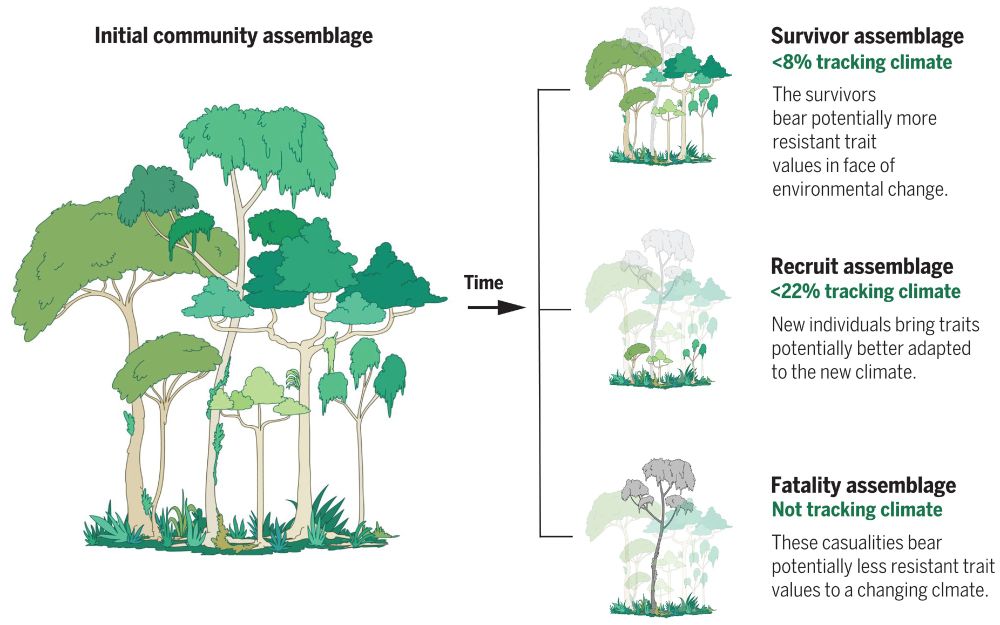
Conceptual figure depicting the analyzed mechanisms for change in community trait composition across the study area.
Tree individuals that are alive and have a DBH ≥10 cm are part of the full community assemblage. Across time, there can be changes in the community trait composition due to growth of the surviving tree individuals (survivor assemblage) given their increase in basal area (top right). Other mechanisms for changing community trait composition across time are the recruitment (recruit assemblage) of new individuals (middle right) and the death (fatality assemblage) of individuals in the community (bottom right).
Imagine this: the Amazon and other tropical forests are like nature’s lungs 🌎
But those lungs? They’re wheezing
A new study shows these forests aren’t adapting fast enough to climate change. They're struggling to keep up
It’s not just trees at risk - it’s all of us
🧪 www.science.org/doi/10.1126/...
14.04.2025 14:09 — 👍 60 🔁 33 💬 1 📌 0
Come join us in the Biodiversity, Ecology and Behaviour team at University of Waikato @waikatouniversity.bsky.social! We are advertising a 3-4 year Lecturer position in Animal Behaviour. Especially ideal for anyone specialising in vertebrates! 🌏🌐 www.seek.co.nz/job/83279795...
05.04.2025 09:38 — 👍 29 🔁 22 💬 0 📌 0
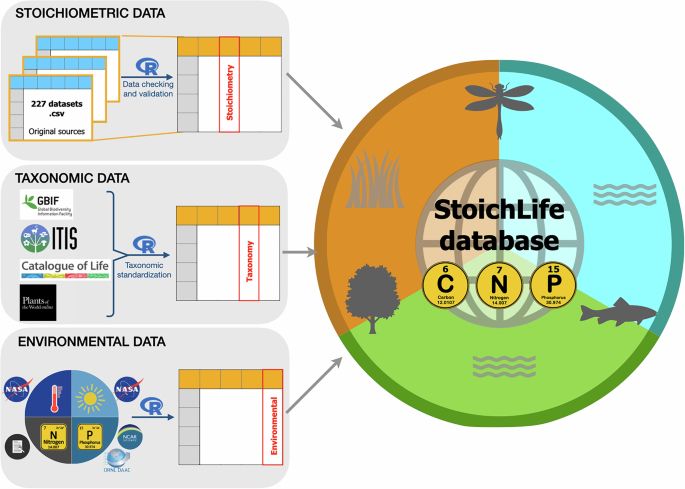
StoichLife: A Global Dataset of Plant and Animal Elemental Content - Scientific Data
Scientific Data - StoichLife: A Global Dataset of Plant and Animal Elemental Content
I’m thrilled to finally share our new dataset paper-years in the making! This has been an incredible rewarding project, and it was a true pleasure to work with such an amazing team of researchers. Huge thanks to supported by @idiv for the support www.nature.com/articles/s41...
03.04.2025 18:36 — 👍 80 🔁 33 💬 4 📌 3
Call for papers - Biological Invasions in The Context of Global Environmental Change | Oikos Journal
OIKOS @oikosjournal.bsky.social
CALL FOR PAPERS - BIOLOGICAL INVASIONS IN THE CONTEXT OF GLOBAL ENVIRONMENTAL CHANGE
www.oikosjournal.org/blog/call-pa...
31.03.2025 01:03 — 👍 6 🔁 4 💬 0 📌 0
#MarineEcology #FreshwaterEcology #IntegratedAssessments #WFD #MSFD #SynthesisResearch #BigData
31.03.2025 10:27 — 👍 8 🔁 5 💬 0 📌 2

Why aren't more researchers publishing in society journals?
Two potential reasons:
1) They're often unfamiliar to early-career researchers,
and/or 2) they need better promotion, a task for all of us.
24.03.2025 22:42 — 👍 45 🔁 15 💬 7 📌 3

@eawag.bsky.social 2-Year Postdoctoral Fellowship.
🧬💧🌐🟦🔬🐟🌍🦐
Highly attractive #independent #postdoc position to to conduct relevant and innovative research in aquatic sciences.
Apply here: apply.refline.ch/673277/1246/...
14.03.2025 15:23 — 👍 14 🔁 14 💬 0 📌 0

Complexity and interpretability in global change ecology
New Opinion article by @danimontoya.bsky.social and colleagues: "Complexity and interpretability in global change ecology"
journals.plos.org/climate/arti...
@granjel.bsky.social @huangmj.bsky.social
21.03.2025 11:17 — 👍 17 🔁 9 💬 1 📌 3
As much as 35% of the human population lives on river floodplains 🧵🧪
24.03.2025 20:23 — 👍 22 🔁 6 💬 1 📌 0

Two studies in the same issue of Science examine macroecological biodiversity-ecosystem function relationships, showing that they fit broader scale sampling processes. Interesting, but with most things in ecology, the deviations are intriguing.
https://bit.ly/4iGN0eQ
https://bit.ly/4iWWUsv
25.03.2025 13:33 — 👍 9 🔁 1 💬 0 📌 0

Hypothesized biogeographic scenarios for the colonization of Fiji by Brachylophus, occurrences of fossil iguanids (i.e., Pumilia, Armandisaurus, and Queironius), and distribution of modern iguanids. The world map is set at 34 Ma on a Robinson projection. The paleogeographic map data were assembled using the R package rgplates using the plate model from Müller et al. (52, 53).
And now for some good news: Iguanas rafted more than 8,000 km from North America to Fiji doi.org/10.1073/pnas...
26.03.2025 08:40 — 👍 209 🔁 66 💬 12 📌 5
Community Ecology is an international peer-reviewed scientific journal focusing on community ecology and population studies. Part of Springer Nature and Akadémiai Kiadó.
IF (2024): 2.0; SJR: Q2 (in Ecology)
springer.com/journal/42974
Head, School of Biological Sciences, Monash University. Physiology | life history | ecology | evolution | higher education
Ecology professor | Global citizen | Local agriculture supporter | Father to a prodigy | iecolab.org
Postdoc. Aquatic Ecology. Biodiversity. Argentina.
Postdoctoral researcher at ICM-CSIC in the iMARES. Marine ecosystems and trophic ecology. My passion 🌊 #stableisotopes #historicalecology #MSP
Studying metabolic evolution, microbial macroevolution, biospheric self-organization, and the feedbacks between Earth and life. Dad, Husband, Scientist.
https://rogierbraakman.com/
Lecturer, Monash Uni. Research focus: animal movement, citizen science, conservation, global change. First-gen MS, PhD.
More: https://shawanchowdhurylab.com/.
Assistant professor - University of Trieste
Plants, functional traits, abiotic stress tolerance
Beatriz Galindo Professor at UMU exploring how #biodiversity shapes #EcosystemFunctioning in river networks | Trust me, I'm a #dogtor | Trail runner | He/him
Ecologist | Professor - State University of Maringá, Brazil
Freshwater Ecology | #aquaticplants #biodiversity #ecology #freshwater #InvasiveSpecies https://scholar.google.com/citations?user=X-qo7OkAAAAJ&hl=en
Professor of marine biology at James Cook University, Australia - #biodiversity #coralreefs #fish #sharks #stress #physiology #evolution #conservation #climatechange #physioshark #TEDx #LGBTQ #STEM
I’m campaigning for more messy spaces for nature, join our messy mission and let’s Rewild together by doing less- and letting nature do the rest!
PhD researcher - Rewilding with Beavers 🦫
Founder of the Wee Pond Project 🐸
TT-IV Fellow at @leveg.bsky.social 🇧🇷 | Forb enthusiast 🪻| Tropical savannas & open ecossystems 🌾| Advocating for FAIR open science 🔓 | #SavannaEcology #DataScience | https://gabrieladezotti.github.io/gdezotti.github.io/
Promote conservation education, outdoor recreation, and environmental literacy. We serve our members, the Twin Tiers community, and all visitors to our collection of nature preserves. (Border counties of Central New York and Pennsylvania.)
Award-winning science communicator, bestselling author, TV personality & co-founder of Scientists for XR - making STEM fun, fighting misinformation & advocating for diversity.
AuDHD, she/her
2x TEDx speaker, 4x cat lover
www.emilygrossman.co.uk
Canal oficial do Conselho Nacional de Desenvolvimento Científico e Tecnológico.
Acompanhe aqui avanços e resultados de pesquisas apoiadas pelo CNPq.
Tropical forests in our time - people, trees and climate. Posts by Oliver Phillips.
From 🇨🇴 to 🇺🇸 to🇨🇭to 🇨🇦. 🧪
Assistant Prof. Ecology, Macroecology. Tweets english & spanish & french #CienciaCriolla #WomeninSTEM #MujerEnCiencia #LatinasinSTEM. thepazlab.com
Bienvenidos a la cuenta oficial del Instituto de Ecología y Biodiversidad. (IEB)
Realizamos investigación de frontera en ciencias de la biodiversidad para el desarrollo sustentable de Chile.
https://ieb-chile.cl/
Eco-evolutionary dynamics explorer | Bridging Ecology, Evolution and Biodiversity Conservation | Associate Editor Functional Ecology | Eternal Judo /BJJ grasshopper.
Website: https://bastazini.github.io
Blog: https://geekcologist.wordpress.com




